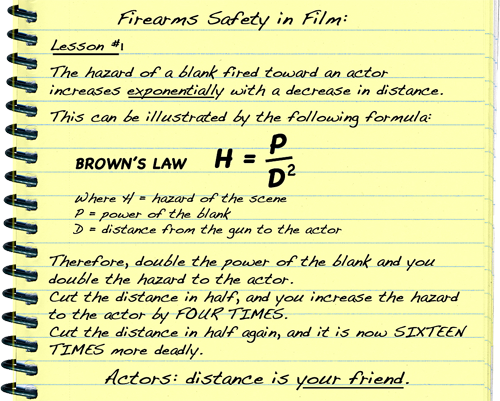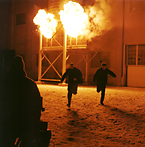The Top Ten Myths about
Firearms on Film Sets
“Productions that don't pay the cost to hire professionals
may be staggered at the cost of hiring an amateur."
There are lots of myths involving firearms safety on film sets. Let’s compare some common myths with the actual reality of firearms on film sets.
Blanks
Myth #1: “Blanks are harmless.”
Reality: At close range, blanks can be extremely dangerous. This is why firearms on film sets must always be handled by qualified experts and not just anyone who happens to have some kind of licence. It takes experience, training and knowledge to understand the dangerous ranges of blanks and how to work with them safely and quickly.
Myth #2: “Okay then. Blanks are too dangerous for filmmakers to use.”
Reality: Not at all. When handled properly and directly supervised at all times by qualified experts, firearms are no more dangerous than any other prop on set. Blanks look better on camera, help actors feel their characters and adds an element of realism impossible to achieve any other way. Blanks can be quick, safe and inexpensive in comparison to trying to do the same effects in post production. Visual effects can look fake if not approached properly and professional actors generally hate acting with a ‘toy’ gun in their hand.
Myth #3: “My uncle owns guns or my buddy is a cop. I can get them to handle the blanks.”
Reality: Firearms are no place for amateurs. Movie firearms require specialized handling and safety procedures, and even replica firearms have legal requirements on supervision, transportation, storage and notification. Filmmakers have a legal obligation to protect the safety of their cast, crew and bystanders. Amateurs handling firearms or productions cutting corners by doubling up crew positions have led to some tragic incidents. Anyone with a firearms licence is NOT QUALIFIED handle firearms on a film set. Some kind of licence in one's pocket no more qualifies a person to handle firearms or replica firearms than a drivers licence qualifies someone to drive a stunt car.
Myth #4: “So all I need to do is keep people a safe distance away when firing blanks.”
Reality: There is NO safe distance in front of a blank. There are only SAFER distances. Granted, a mile away might be safe; a foot away is not safe. It is the distances in between that become critical to understand the many different factors that go into how safe it can be to shoot a particular scene. Blanks fire explosive bursts of burning gases plus flakes of burnt and unburnt gunpowder out the barrel with a great deal of explosive force. This force dissipates rapidly with distance but every firearm has a different dangerous range. This is why firearms safety specialists spend a great deal of their time testing and learning about the characteristics of every firearm before it is used on set.
Myth#5: “I read a safety rule that one should always use the lowest power blank possible.”
Reality: Not true. Blanks can often be supplied in 1/4, 1/2 or full power loads. In some cases, however, it is more dangerous to use lower powered loads than full power. Semi-automatic and automatic firearms must be specially modified to fire blanks, and the action will only cycle properly with loads designed for them. If lower power loads are used, the firearms may jam. This can be extremely dangerous because a jammed firearm can still go off at any moment.
Myth #6: “But aren’t 1/4 loads less power than 1/2 loads or full loads?”
Reality: Not always. The terms “1/4 load” “1/2 load” and “full load” are essentially meaningless unless you are using them to compare the same manufacturer's loads in the same firearm. The power of a blank depends directly on how much gunpowder is in it and inversely on the square of the distance away from the muzzle. Also, all firearms have differing characteristics. Some have an open barrel, some use a restrictor plate and some have baffled barrels. There is no way to predict the hazard simply by the designation on the box. A 1/2 power .45 calibre blank can be more powerful than a full power 9mm blank. A 1/4 load shotgun blank is greater than a full power handgun blank, and rifle blanks can be 10 times more hazardous than the most powerful handgun blank.
Myth #7: “Then it is always safer to be farther away.”
Reality: Distance is your friend. It is better to increase the distance between a firearm and an actor than it is to decrease the power. In rare cases, however, it can be safer to be REALLY close. It is all about control. If actors are six feet apart, it is difficult to control and there is no way to rely on the actor always hitting their mark perfectly in order to keep people safe. This is why blanks are almost never fired toward another person on a film set. Even at farther distances, debris can hit someone in the eye. (Eye protection is one of our biggest concerns.) But an experienced expert can work inches away, given enough face and body protection on an actor. Firearms Safety Coordinators are not only there for safety and authenticity; they know many ways to deliver the scene the way the filmmaker wants - safely, inexpensively and quickly.
Due to the nature of blanks and their explosive force out a firearm’s barrel, distance of the gunshot to the cast and crew will always be more critical than the power of the blank. This is because the hazard of blanks increases EXPONENTIALLY with a decrease in distance. This can be illustrated by BROWN’S LAW on the hazards of blanks in film firearms:
Firearms
Myth #8: “Firearms are dangerous. Disabled firearms or replicas are safe."
Reality: Since the dawn of filmmaking, there have been zero fatalities on film sets when firearms are handled by qualified experts. This is an enviable safety record of over 130 years! In every incident on film sets where people were injured or killed, productions didn't hire qualified experts; cut corners to save costs; doubled up crew positions to save money or circumvented standard industry safety practices. While the trend in the film industry is toward more use of replica firearms, they STILL need an expert to supervise them. There are numerous legal and safety issues that arise, even for something as simple as painting a toy gun to look real. Even CO2-powered firearms need safety checks and safety briefings and if your replica firearms are walking off set unsupervised, the production is both legally and civilly liable for anything that may happen. Firearms, real or fake, must ALWAYS be treated with respect.
Safety
Myth #9: “Expertise costs money. I can’t afford to hire experts.”
Reality: Lack of money is no excuse for getting people hurt. Productions that tried to save money by not hiring professionals have been STAGGERED at the cost of hiring amateurs. One second of stupidity by irresponsible productions can destroy relationships, put cast, crew and the public at serious risk and cause fear and apprehension on set.
Myth #10: “So the firearms expert is on set to keep people safe.”
Reality: Firearms experts go by a variety of titles, depending on jurisdiction. Called "Firearms Safety Coordinators" here in Manitoba, or "weapons handlers" and "armorers" in other jurisdictions, it is a common myth that they are there just to supply the firearms or to keep people safe.
Firearms experts contribute directly to the look of a film; help move the story forward; influence the realism and authenticity of the scene; and - most important of all - help cast and crew relax and do their jobs when firearms and replica firearms are on set. Firearms experts are not on set to just handle the guns; they are on set to work with PEOPLE. This is why safety meetings, safety briefings and safety inspections are just as critical with replica firearms as they are with real firearms. It is not just a matter of keeping people safe; it is a matter of making sure they KNOW they are safe.
